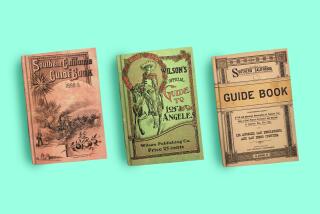Guidebook Options Are Plentiful
- Share via
There comes a time when more isn’t better--it’s just bewildering.
Thankfully, the travel-guidebook industry hasn’t reached that point yet, but it’s fast approaching it. So it is a smart traveler who researches the research, so to speak, before choosing a guidebook.
“In the late 1970s there was one section of shelving for guidebooks” in most bookstores, said Karen Cure, editorial director of Fodor’s Travel Publications in New York City. “Now you don’t get a foot of Italy books; you get 6 feet.”
And that doesn’t even take into account the expanding number of popular travel destinations, and therefore travel books, as well as specialty guides.
“The customer is the winner here,” said Michael Spring, publisher of Frommer’s travel publications in New York. “Everyone is frantically trying to outdo everyone else.”
That frantic search for the edge of the travel-guide market has produced a dizzying array of options helped along by a healthy economy and robust tourism.
There are guides that download into palm-sized computers, free guides on the Internet, pocket-size guides with pullout maps, exhaustive 1,000-page tomes that could double as textbooks and glossy guidebooks that would make any coffee table proud.
“We wanted to make travel guides different than what everyone else was doing . . . something people would keep,” said Lucy Kenyon, publicity manager at Eyewitness Guides.
They succeeded. You could practically hear the collective gasp when the first Eyewitness Guides hit the market a few years ago.
They were everything guidebooks had not been--colorfully pretty, well photographed, artistic and non-disposable. Heavy on maps, graphics and the enduring sights in a city or country, Eyewitness Guides have one noticeable drawback--they contain only the skimpiest information about hotels and restaurants.
“They are cultural guides primarily,” Kenyon said. “They focus on sites that have staying power . . . cathedrals and museums.”, That’s why you’ll probably want to buy a companion guide or two if you choose an Eyewitness Guide. “Most people still want a workhorse of a guide--something that gives them details that will safeguard their trip,” said Spring. “I wouldn’t trust my vacation to a book that was 4 years old.”
Most if not all travel guidebooks are updated annually or every two years, while the Eyewitness Guides and the new National Geographic Traveler series will be updated every three to five years. These two series, printed on heavy, glossy paper and requiring teams of graphic artists, photographers and cartographers, are too expensive to change every year.
At the opposite end of the spectrum are travel books by Lonely Planet and Rough Guide. Even skimming these thick guidebooks means wading into a country’s culture, politics and history.
“Too much of the tourist industry and travel books, if you can call them that, deal with countries in a superficial, never-never-land way,” said Simon Carloss, marketing manager of the well-respected Rough Guide series, formerly Real Guides. “We attempt to interject some realism into it . . . [by bringing] a journalistic relish to it.”
The newly diverse travel-guide market also means that you can have comprehensive information and brevity, too, with the advent of condensed guides from publishers who know you don’t want to lug an 800-page guidebook around. They know you love gadgets, so many are making guidebooks that will download into your computer.
They know that you are interested in things you can do with your kids, so they publish “family vacation” books. Fodor’s, which already has a 14-book series, just launched its “Around the City with Kids” line.
More to Read
Sign up for The Wild
We’ll help you find the best places to hike, bike and run, as well as the perfect silent spots for meditation and yoga.
You may occasionally receive promotional content from the Los Angeles Times.






